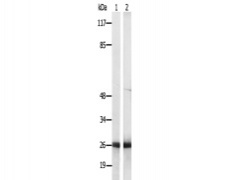中文名称:兔抗ATP5H多克隆抗体
|
Background: |
Mitochondrial ATP synthase catalyzes ATP synthesis, utilizing an electrochemical gradient of protons across the inner membrane during oxidative phosphorylation. It is composed of two linked multi-subunit complexes: the soluble catalytic core, F1, and the membrane-spanning component, Fo, which comprises the proton channel. The F1 complex consists of 5 different subunits (alpha, beta, gamma, delta, and epsilon) assembled in a ratio of 3 alpha, 3 beta, and a single representative of the other 3. The Fo seems to have nine subunits (a, b, c, d, e, f, g, F6 and 8). This gene encodes the d subunit of the Fo complex. Alternatively spliced transcript variants encoding different isoforms have been identified for this gene. In addition, three pseudogenes are located on chromosomes 9, 12 and 15. |
|
Applications: |
WB |
|
Name of antibody: |
ATP5H |
|
Immunogen: |
Synthesized peptide derived from internal of humanATP5H. |
|
Full name: |
ATP synthase, H+ transporting, mitochondrial Fo complex, subunit d |
|
Synonyms: |
ATPQ |
|
SwissProt: |
O75947 |
|
WB Predicted band size: |
18 kDa |
|
WB Positive control: |
HepG2 cells and Jurkat cells lysates |
|
WB Recommended dilution: |
500-3000 |

 购物车
购物车 帮助
帮助
 021-54845833/15800441009
021-54845833/15800441009
